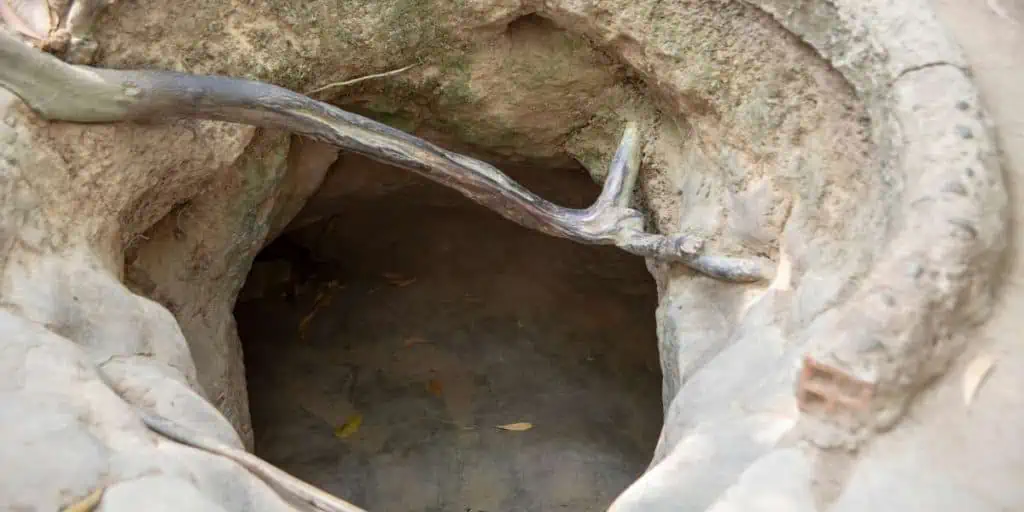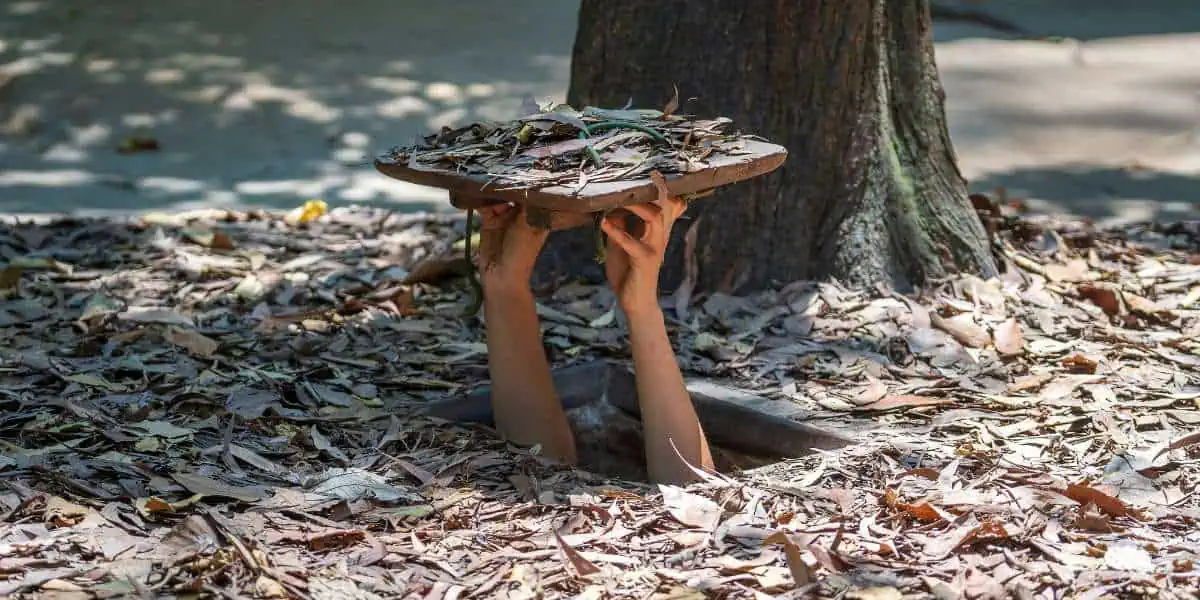Embark on a riveting historical adventure through Vietnam’s rich and complex past at the War Remnants Museum and Cu Chi Tunnels. These two iconic landmarks offer an unflinching and thought-provoking glimpse into the Vietnam War, providing deeper understanding of the country’s resilience and the far-reaching impact of modern industrialized warfare.
The War Remnants Museum – An Uncompromising Portrayal of War’s Brutality
The War Remnants Museum in Ho Chi Minh City forgoes glorification of war for a frank display spotlighting its horrendous consequences for combatants and civilians alike.
Originally named the Exhibition House for US and Puppet Crimes, then the Exhibition House for Crimes of War and Aggression, the museum was finally renamed the War Remnants Museum in 1990. However, its mission remains steadfast over the years – serving as an unflinching testament to the atrocities inflicted during the Vietnam War.
Upon entering, gaze up at fighter jets, bombers, and helicopters suspended from the ceiling – stark remnants of the bombing campaigns that ravaged Northern Vietnam. Peer out the dusty windows of an armored personnel carrier while surrounded by mannequins decked out in full combat gear. These striking displays set the stage for the museum’s thoughtful exhibitions chronicling different facets of the protracted conflict.
Harrowing Second-Hand Witness Accounts
Delve into the museum’s thought-provoking galleries showcasing harrowing images of wounded soldiers, destroyed villages, and devastating legacies of chemical weapons. Veterans’ first-hand quotes detail their haunting memories of combat alongside graphic photographs capturing the anguish of war. One searing image depicts a napalm strike victim – a terrified young girl running naked down a highway with skin melting off her arms.
Cringe at the extensive collection of barbaric torture instruments used against Viet Cong captives and political prisoners. Read heart-wrenching letters from Viet Cong fighters constrained in Tiger Cages – tiny stone enclosures exposing occupants to extremes of heat and cold, deprived even of basic hygiene needs.
These vivid and troubling displays underline war’s humanitarian catastrophes, illuminating the very personal tragedies drowned out by broader strategic narratives. They highlight the Vietnamese people’s tremendous suffering and residential strength amidst the calamities of modernized warfare.
Multimedia Displays Overviewing Key Events
Gain a thorough overview of the origins underpinning US involvement, pivotal battles, and bitter aftermath through extensive multimedia displays. Informative plaques summarize different phases of engagement spanning over two decades, underscoring how both sides endured tremendous losses.
An expansive tabletop miniature diorama chronicles milestone moments across all theaters of battle. Marvel at the breadth of terrain covered – from the forested Central Highlands to the Mekong Delta’s winding waterways. Appreciate how ingenious Viet Cong battle tactics utilized networks of underground tunnels in rural strongholds to offset American air power dominance.
These visualizations help cement critical events firmly into historical memory. They reveal how the determination of Viet Cong guerilla fighters combined with widespread anti-war sentiment back home to ultimately compel American withdrawal.
Requiem Exhibition Commemorating Fallen Journalists
Conclude your visit by paying respects to fallen journalists at the Requiem Exhibition. Display cases feature the actual cameras and personal artifacts used by photojournalists and reporters killed on assignment in Indochina between 1945 and 1975. These items stand as sobering reminders of the tremendous dangers war correspondents undertook to capture conflict’s stark realities.
The centerpiece is a blood-stained execution shirt worn by Vietnamese reporter Le Van Hoa moments before his public assassination. Hoa worked for an American news agency and was killed by Viet Cong guerrillas who accused him of being a spy. His shirt serves as a symbolic tribute honoring the sacrifices of local journalists striving to spread truth.
Lacquered Paintings Depicting Enduring Legacies
For a uniquely Vietnamese artistic perspective, head upstairs to the lacquered painting gallery showcasing works by veteran artists using unique materials and techniques. Brilliantly colorful yet graphic images depict painful recollections around destroyed communities, napalm disfigurements, enduring disabilities from chemical defoliants, and civilian anguish.
Remarkably, some painters create stunning compositions using just a single strand of cotton thread wound across textured acrylic undercoating. This eloquent style aptly captures war’s complexity by creating beauty out of brutality while underscoring the fragility of life.
Cu Chi Tunnels – Storied Underground Shelters of War

Just a short drive from Ho Chi Minh City near the village of Cu Chi, discover the fabled Cu Chi Tunnels – an immense underground network that served as both supply routes and secret bedrock community for Viet Cong guerilla fighters during the Vietnam War. Used from the 1940s all the way through the 1960s and 1970s, these storied tunnels played a pivotal tactical role thwarting US military efforts to control the region.
Embark on a guided tour of the tunnels led by interpreters possessing deep knowledge regarding their conception and evolution. Follow their lamplit lead crawling on hands and knees to traverse narrow subterranean arteries little more than two feet across. Imagine entire families dwelling for years entirely underground, rarely seeing daylight while American bombs decimated landscapes above.
Ingenious Tools for Subterranean Survival
Witness the Viet Cong’s extraordinary ingenuity and adaptability by inspecting improvised tools and trap mechanisms used for subterranean survival. Peek into intricately-camouflaged quarters hewn from laterite clay, furnished with beds, chairs, wood-burning stoves, and ventilation shafts. Marvel at tunnels outfitted as kitchens stocked with clay pots and utensils for preparing hearty stews – resilient testaments to steadfast perseverance nourishing communal bonds.
Reflect on the tunnels’ piecemeal genesis, manually expanded over decades by residents determined to secure sanctuary against continual outside threats. Appreciate how they tapped local vegetation for remedies from fish poison plants and wild yams while turning American unexploded bombs into stove boilers and weapon parts.
Even brief exposure to such confined earthen corridors readily showcases how solidarity devotion and resourcefulness ultimately overpowered the world’s strongest military equipped with seemingly unlimited munitions.
Replica Booby Traps Spotlighting Viet Cong Improvisation
Your guide will also highlight the numerous booby traps employed by Viet Cong defenders to snare trespassers and frustrate American tunnel extermination efforts. Encounter recreations of fiendishly clever devices made from sharpened bamboo, saved munitions, and materials at hand – gruesome testaments to battlefield innovation.
Gain profound respect for American “tunnel rats” who risked life and limb entering these claustrophobic passages festooned with toxic spear traps, collapsing ceilings, and hidden gunports. A special tunnel display features their specialized gear like snakebite serum, daggers, and custom pistols designed for narrow spaces.
Ultimately, the tunnels stand as monumental symbols celebrating Vietnamese resolve and tactical adaptations turning weakness into strength. Their very scale underscores how America vastly underestimated nationalist zeal and inexorable will rallying both combatants and community alike.
Expert Guidance Illuminating History
To fully appreciate these landmarks’ sweeping historical significance, engage an expert guide’s veteran insight shedding light on their most moving narratives. These experienced historians and battlefield interpreters add invaluable context regarding exhibits and displays.
War Remnants Museum guides greatly enhance exhibits like tiger cages and torture devices by detailing their original locations while clarifying significance as powerfully hated symbols among the Vietnamese people. They thread connections across different galleries under unified themes like chemical defoliant impacts still felt today through elevated cancer rates and birth defects.
At Cu Chi Tunnels, knowledgeable guides share enthralling vignettes about defiant local fighters along with tactical and engineering feats keeping exit routes open despite intense bombing campaigns. They deliver emotive eyewitness accounts and proudly relate how their own parents and grandparents actively fought in or supplied these fortified underground networks.
Engage fellow travelers in meaningful discussion facilitated by expert narratives tying human consequences across generations to decisions made by key policymakers on both sides. Gain sobering perspective on how aggressive tactics undermine moral authority and often backfire by strengthening resolve for self-determination.
Conclusion
From incendiary photography and candid soldier accounts conveying visceral battlefield horrors to sturdy tunnel networks sheltering resolute defenders, the War Remnants Museum and Cu Chi Tunnels spotlight different but complimentary facets of the Vietnam War’s deep impact shaping modern Vietnam.
These sensitive guided explorations deliver unflinching insight into war’s devastating legacies fiercely defending one’s homeland against external threats. Paying respects to ubiquitous suffering while celebrating human resilience dispels simplistic analyses regarding conflict’s chaotic roots and enduring





